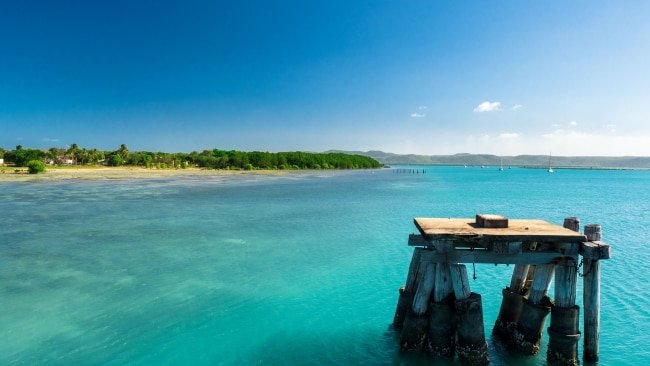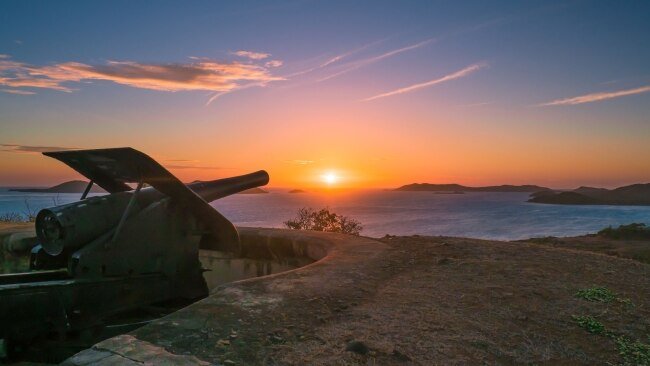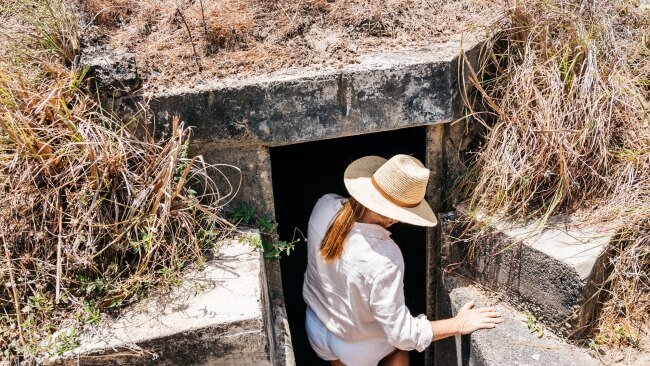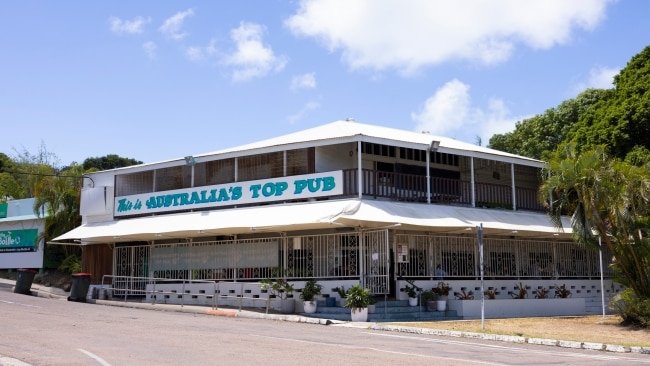Torres Strait Islands stunning beauty hides the dark past of WWII
Taken from Escape
12 May 2023
This idyllic Australian island destination has been largely overlooked by tourists - but it holds the alarming record of being attacked by 500 bombs.
Sitting on the bow of a small white boat, travelling across water so turquoise it looks as though someone’s gone OTT with the “vivid” filter, it’s hard to believe anything bad could ever happen here.
But for 18 months during World War II, one of the idyllic islands in this remote northern Australia outpost was the target of an intense campaign of Japanese air raids. Between 1942 and ’43, an estimated 500 bombs were dropped on Horn Island (Ngurapai) in the Torres Strait (Zenadh Kes), making it the second most attacked location in Australia, behind Darwin.
If this comes as a surprise to you, you’re not alone. I’m travelling with my two kids, aged 12 and eight, on a short flight from Cairns, but I’m yet to meet anyone else who’s been here.
We land early afternoon at Horn Island Airport, which makes Cairns look like a major international hub. There’s a guy doing a brisk trade selling hot chicken and spring rolls to the delayed departers (he tells us happily that delays and cancellations are commonplace), and there’s a small war memorial out front commemorating those who served and died here.
A short bus ride later, we’re at the picture-perfect wooden jetty, where the “recent crocodile sighting” sign is doing little to deter locals casting a line for bait fish. Our destination is neighbouring Thursday Island (Waibene), known locally as TI, where most visitors stay during a visit to Torres Strait.
A small ferry takes us on the 15-minute trip across that greener-than-blue water. We’re greeted warmly at the TI Motel, which is more attractive that you might glean from the name – it’s spacious, comfortable, and also in a terrific location just off the beachfront and within walking distance of everything you might want to see. (To be fair, this isn’t hard on an island that measures about 3.5sq km.)
Arriving late in the afternoon, we take a walk up to Green Hill fort, the highest point on Thursday Island, where I marvel at the 360-degree views over the surrounding islands, while the kids film themselves clambering over the three (decommissioned) 10-tonne guns. The fort was built in 1891 as part of Australia’s defence against a feared Russian invasion, and the underground rooms that once stored ammunition are now home to the Torres Strait Historical Society Association museum, which opens daily to coincide with tour groups.
But what most people come up here for is the nightly sunset show – the sky swathed in orange and pink as the sun sets over Friday Island (Gealug) and Goods Island (Palilug) to the west.
There are two pubs on TI and seeing as we’re here for two nights, there’s only one decision to be made. After the flip of a coin, we put on our smart thongs and head out to The Grand for a bistro meal on the deck overlooking the Endeavour Strait (they say you can see Cape York Peninsula before sundown). Then follows a few rounds of musical bingo with the easygoing, happy cultural mix of local Torres Strait Islanders, resident mainlanders, and visitors. We return to base humming Rick Astley, ready for an early night.
On Saturday morning, our alarm sounds before dawn. We’re booked on a boat tour with the locally owned and run Lax Charters and Tours (“Lax” is how the locals say relax), and the sight of the sun rising over neighbouring Friday Island validates the early start. Our guide, Dirk, takes us across to one of the Torres Strait’s last remaining pearl farms – a remnant of a trade that boomed in the late 19th century. We cruise along the coastline of Prince of Wales Island (Muralag), the largest of the 274 Torres Strait Islands, known for its pristine waterfalls and hidden fishing spots (Dirk knows where they are), and the uninhabited Goods Island, where you can take a hike to the lighthouse.
Dirk drops us off back at the Horn Island jetty just before 10. It’s a hot day (winter temps here average around 28C, and in summer, it is hotter and very humid). We cool off with a drink at the Gateway Resort before making our way out back to Torres Strait Heritage – a comprehensive collection of wartime and other artefacts assembled from scratch by the hotel’s proprietors, the Seekee family.
After Japan declared war in 1941, the majority of Thursday Island’s and Horn Island’s civilian population was evacuated to the mainland. TI was the centre for military operations in the Torres Strait, serving as a base for thousands of American and Australian soldiers, including the locally recruited Torres Strait Light Infantry Battalion – Australia’s first and only Indigenous unit. By the end of 1942, more than 800 Torres Strait Islander men had enlisted, working side-by-side with the non-Indigenous troops. Horn Island, used for refuelling and rearming fighter planes heading for battle in New Guinea, was repeatedly attacked during a savage 18-month campaign.
Vanessa Seekee and husband Liberty also run the “In Their Steps” tour of Horn Island’s World War II sites that they have uncovered and restored. Our fellow travellers exploring the underground rooms, slit trenches, artillery pieces and wrecked aircraft are grey nomads who have driven up the long, red corrugated track to the Tip and travelled across to TI by ferry.
Back on TI later that day, we just have time to run into the modern (and air-conditioned!) Gab Titui Cultural Centre before it closes. The Wabunaw Geth Gallery displays ceremonial feathered headdresses (dhari) like the one on the Torres Strait flag, alongside sculptures, carvings paintings and jewellery. It’s a fascinating dive into the myths and legends of the Kaurareg nation, the traditional custodians of the Inner Islands (Kaiwalagal) of the Torres Strait.
There’s also a gift shop and cafe, but after all this history and culture, the 12-year-old is keen to finally get his selfie at Australia’s most northerly pub – the Torres Hotel, known as the Top Pub. Dinner tonight will be a more leisurely affair, as we already know our morning flight has been cancelled.
The writer stayed and toured Torres Strait as a guest of Tourism Tropical North Queensland.
On tour at King Point, Horn Island. Picture: Tourism Queensland







